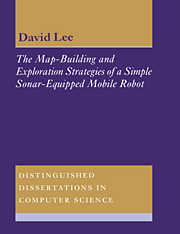 The Map-Building and Exploration Strategies of a Simple Sonar-Equipped Mobile Robot
The Map-Building and Exploration Strategies of a Simple Sonar-Equipped Mobile Robot Book contents
- Frontmatter
- Contents
- Preface
- 1 Question, Context and Method
- I Starting Points
- II System Components
- III Experiments
- 11 Experimental Evaluation
- 12 Wall-Following
- 13 The Results of Localisation
- 14 Supervised Wall-Following
- 15 Can a Human Do Any Better?
- 16 Longest Lines of Sight
- 17 Free Space Boundaries
- 18 Summary of Experimental Results
- 19 Conclusions
- 20 Directions for Further Research
- Appendix A The Feature-Map Data Structure
- Appendix B Test Rooms
- Appendix C Finding the Best-Fit Line
- Appendix D ARNE's Standard Dialogue
- Bibliography
- Index
16 - Longest Lines of Sight
Published online by Cambridge University Press: 05 March 2012
- Frontmatter
- Contents
- Preface
- 1 Question, Context and Method
- I Starting Points
- II System Components
- III Experiments
- 11 Experimental Evaluation
- 12 Wall-Following
- 13 The Results of Localisation
- 14 Supervised Wall-Following
- 15 Can a Human Do Any Better?
- 16 Longest Lines of Sight
- 17 Free Space Boundaries
- 18 Summary of Experimental Results
- 19 Conclusions
- 20 Directions for Further Research
- Appendix A The Feature-Map Data Structure
- Appendix B Test Rooms
- Appendix C Finding the Best-Fit Line
- Appendix D ARNE's Standard Dialogue
- Bibliography
- Index
Summary
16.1 Motivation
Experience with human control of the exploration process suggested that map quality could be increased rapidly in the early stages of exploration by heading into open regions of space instead of staying close to one of the walls (Section 15.4). The ‘Longest Lines’ strategy described in this chapter was motivated by this observation. The essential idea is to perform a full sensor scan and head in the direction of the longest reading. As many steps as possible are then taken in that direction until an obstacle is encountered. The algorithm then continues by heading in the direction of the longest reading from this new position.
This strategy shares with wall-following the fact that it is totally reactive. Navigational decisions are made solely on the basis of the latest sensor readings.
Section 16.2 gives the details of the implementation and Section 16.3 compares the results to those of Wall-Following and Supervised Wall-Following. Section 16.4 summarises the experimental results and considers the strengths and weaknesses of the strategy.
16.2 Implementation
The strategy, as described in the previous section, is straightforward. The only slight complication is the problem of multiple reflections. Wall-following used the shortest range readings from each viewpoint; multiple reflections were not a problem because they typically cause long range readings. On the other hand, the ‘Longest Lines’ strategy is particularly interested in the long readings. It is therefore necessary to acknowledge the likelihood of multiple reflections and to compensate for them.
- Type
- Chapter
- Information
- The Map-Building and Exploration Strategies of a Simple Sonar-Equipped Mobile RobotAn Experimental, Quantitative Evaluation, pp. 163 - 172Publisher: Cambridge University PressPrint publication year: 1996
